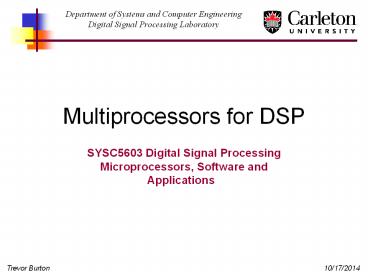Multiprocessors for DSP - PowerPoint PPT Presentation
Title:
Multiprocessors for DSP
Description:
Trevor Burton. Multiprocessors for DSP. SYSC5603 Digital Signal Processing ... M. Chen and K. Olukotun, 'The Stanford Hydra CMP', IEEE Micro, vol. 20, no. 2, ... – PowerPoint PPT presentation
Number of Views:39
Avg rating:3.0/5.0
Title: Multiprocessors for DSP
1
Multiprocessors for DSP
- SYSC5603 Digital Signal Processing
Microprocessors, Software and Applications
2
Outline
- Why Multiprocessor Systems?
- Chip Multiprocessor (CMP) Architectures
- CMP Advantages Disadvantages
- Current CMP Solutions
- Tools for Designing and Simulation CMPs
- Summary
3
Why Multiprocessor Systems?
- Single-core microprocessor performance increases
are beginning to slow 1 due to - Increasing power consumption (gt100 W)
- Increasing heat dissipation
- Diminishing performance gains from ILP TLP 2
- As a result manufactures are turning to a
multi-core microprocessor approach - Multiple smaller energy efficient processing
cores are integrated onto a single chip - Improves overall performance by performing more
work concurrently
4
CMP Architectures
- Two general types of multi-core or chip
multiprocessor (CMP) architectures - Homogeneous CMPs all processing elements (PEs)
are the same - Heterogeneous CMPs comprised of different PEs
- Homogenous dual-core processors for PCs are now
available from all major manufactures - Heterogeneous CMPs are available in the form of
multiprocessor systems-on-chips (MPSoCs)
5
Homogenous CMP - Quad-SHARC DSP
Quad-SHARC Functional Diagram
Core ADSP-21060 SHARC Functional Diagram
3
3
6
Heterogeneous CMP Cell BE
Cell Broadband Engine Block Diagram
4
7
CMP Advantages
- CMPs have several advantages over single
processor solutions - Energy and silicon area efficiency
- By Incorporating smaller less complex cores onto
a single chip - Dynamically switching between cores and powering
down unused cores 5 - Increased throughput performance by exploiting
parallelism - Multiple computing resources can take better
advantage of instruction, thread, and process
level parallelism
8
CMP Disadvantages
- Poorer performance in single task situations
- Need to have software that can be decomposed into
multiple threads in order to take full advantage
of CMP resources - Programming CMPs is inherently more difficult due
to - Software needing to be designed with multiple
threads - Parallel programming and its associated issues
such as shared memory access and message passing - Large number of possibly different types of PEs
9
Current CMP Solutions
- Many different types of CMP solutions exist today
and choosing one depends on the intended
application - In the desktop computing industry all major
manufactures now offer multi-core solutions - Manufactures of PDSPs also offer multi-core
versions of their products - FPGA manufactures offer programmable devices with
immersed microprocessor cores
10
Design and Simulation Tools
- Of the multi-core solutions that exist none offer
support for a multi-core design from scratch - Instead customers decide on a multi-core platform
from a specific vendor and generally use the
tools available from that vendor to program,
test, and verify their multi-core solution - One solution for the design and simulation of
multi-processor systems from the ground up is
offered by Cmpware Inc. - They offer a configurable multi-processor
development kit (CMP-DK) which allows for the
design, programming, and testing of
multi-processor systems
11
Design and Simulation Tools The CMP-DK
- Their development environment lets processors and
their interconnection network be quickly and
simply defined 6 - Existing processor cores along with their
associated tools, libraries, and software can be
used 6 - Also, users are able to specify their own custom
processor architectures and interconnect networks
or modify an existing architecture as needed.
12
Summary
- The CMP architecture is now the architecture of
choice for semiconductor manufactures - CMPs are more area and energy efficient than
single processor solutions - CMPs achieve greater throughput than single
processor solutions as more work can be done
concurrently - Custom multi-processor systems can now be
designed and simulated from the ground up using
software solutions from several companies
13
References
- 1 D. Geer, Chip makers turn to multicore
processors, IEEE Computer, vol. 38, no. 5, pp.
11-13, 2005. - 2 L. Hammond, B. Hubbert, M. Siu, M. Prabhu, M.
Chen and K. Olukotun, The Stanford Hydra CMP,
IEEE Micro, vol. 20, no. 2, pp. 71-84, Mar./Apr.
2000. - 3 AD14060 Data Sheets. (2004). Analog Devices.
Norwood, MA. Online. Available
http//www.analog.com/UploadedFiles/Data_Sheets/
4003696AD14060_L_b.pdf - 4 Cell Broadband Engine Architecture and its
first implementation. Online. Available
http//www- 128.ibm.com/developerworks/power/libr
ary/pa- cellperf/23ref1
14
References
- 5 R. Kumar, D. M. Tullsen, N.P. Jouppi, and P.
Ranganathan, Heterogeneous Chip
Multiprocessors, IEEE Computer, vol. 38, no.
11, pp. 32-38, 2005. - 6 S. A. Guccione. (2005, April). Programming
Configurable Multiprocessors. Presented at the
12th Reconfigurable Architectures Workshop.
Online. Available http//www.cmpware.com/Pape
rs/RAW2005/Cmpwar e_RAW_2005.pdf































